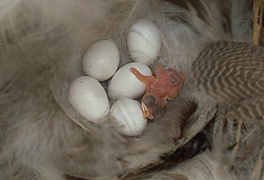
At Your Boxes:
Your Control Sheet for tracking Tree Swallow nesting attempts shows the earliest nests at your Tree Swallow project have reached incubation day 13 or 14, when eggs normally start hatching. Carefully opening these boxes you should see eggs hatching and small Tree Swallow nestlings. Be proud! Your careful management has permitted these little guys to be here at this place. Photo above by Dick Stauffer of Alberta.
Pick up a brood of nestlings one by one and cradle them in your cupped hand. How do you pick up a tiny nestling? Very gently and carefully lift them one at a time out of the nest and transfer them to your other, cupped hand. It may be scary for you the first few times you do it, but remember they are tough little critters and lifting won’t hurt them. Get comfortable handling nestlings. You’ll be doing it a lot. Also get used to being defecated on! Don’t take it personally, it’s a nestling’s reflex.
And don’t worry if the adults fly around overhead, and scream and dive on you. After you’ve counted the young and any unhatched eggs, returned the young to the box, and moved off to the next, the parents will settle back down again.
Concepts:
What happens within an egg shortly before hatching starts?
- The embryo grows to the point where it takes up nearly all the interior space.
- It positions its body so its head is at the large end of the egg next to the air space.
- A few days before hatching, it uses its bill to poke a hole through the membranes into the air space. Now it can begin to breathe with its lungs, although the chorioallantoic membrane, the CAM, is still the main structure for gas exchange.
- Most remaining albumen and yolk is now consumed by the embryo.
- See Incubation in Tree Swallows for more on embryonic development.
How do bird eggs hatch?
- Bird embryos use an “egg tooth,” not a real tooth but a small sharp temporary structure on the top of their bills, to cut through their shells from the inside.
- The eggshell is thin and weak now because the growing embryo has been absorbing calcium from it to build its bones.
- The embryo uses a special muscle in the back of its neck to rub its egg tooth against the weakened shell. Eventually, the egg tooth cuts a small hole at one spot in the shell (see below).
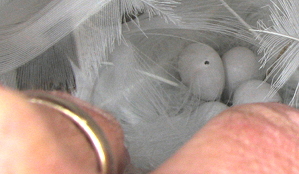
- As it continues to rub with the egg tooth, the embryo rotates its body, gradually cutting a circular ring around the middle of the shell as it turns (see egg at upper left in the photo below by Elinor Schindel).
- When the cut is complete, the hatching bird pushes against the large end of the shell with its head and shoulders, and against the narrow end with its legs and feet, forcing the eggshell halves apart.
- Finally, the hatchling works itself free of shell membranes and separates itself completely from the shell halves.
- The hatching process can take small songbirds several very tiring hours.
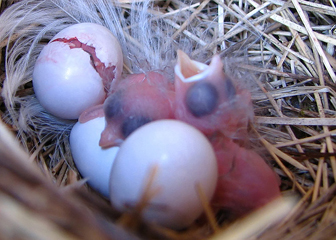
You may find “pipped” eggs, ones in the process of hatching, when you make box checks.
- A “pipped” egg is one that shows a few small holes or a thin line in the shell where the embryo has begun cutting.
Warning! Do not touch pipping eggs! Damaging the shell at this time could make it difficult or impossible for the bird to hatch.
What happens to empty shells after hatching? Where do they go?
- In some species, including Tree Swallows, female birds eat the shells, probably to regain minerals drawn from their bodies when the shell was produced.
- Here’s a video from Francois Paquette of Quebec showing a Tree Swallow female crushing and swallowing eggshells of her newly-hatched young.
- Parents of some other species carry shells away and discard them.
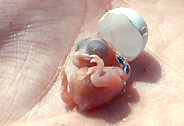
You may find that not all eggs hatch. Why is this? Do ones that didn’t hatch appear different?
- Some eggs may not have been fertilized due to mating difficulties or sterility of one of the pair of adults.
- In other eggs, embryonic death may have occurred due to genetic defects, exposure to cold, or attack by germs able to penetrate shells and membranes.
- Still other unhatched eggs may be light in weight because air has leaked in, drying the contents and killing the embryo.
- Some unhatched eggs will look odd. Note the large white air spaces and darker small ends of the two eggs at right in the photo below.
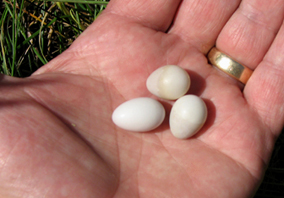
- If examined under light such eggs may seem clear and watery inside, with no sign of an embryo.
- The egg below being candled with a flashlight by Erna Giesbrecht of Manitoba, was one of five similar eggs incubated for almost a month. No embryos were visible inside, and none hatched.
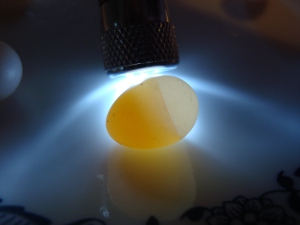
- In many Tree Swallow nests one egg hatches a day later than the others. We’ll be discussing this later.
- If an egg has not hatched after young in a nest have reached three days old, we assume it is not alive and remove it.
What are young Tree Swallows like when they hatch?
- They are tiny, only weighing between about 1.3 and 1.8 gm.
- They are mostly naked, except for little whiffs of down on backs and heads.
- Some internal organs and the last of the yolk are visible through the thin skin of the abdomen.
- Their eyes are large but completely closed.
- Those beaks are large, with fleshy yellow edges.
- Their wings look like thin little paddles.
- Their legs are much bigger than their wings.
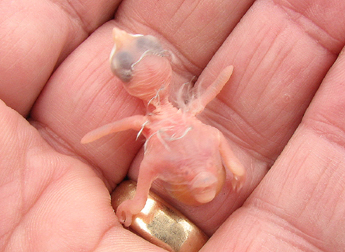
Can small Tree Swallow nestlings move after hatching?
- Although mostly helpless and weakened by the hatching process, they can raise their heads on wobbly necks, open their mouths, and wave their tiny wings.
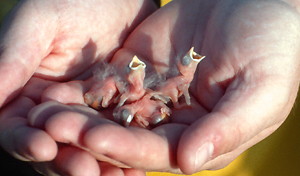
What is the purpose of these movements?
- This is “begging,” a set of behaviors the young instinctively “know” how to perform from the moment of hatching.
- Begging of songbird nestlings is usually a combination of postures, movements, and calls, which signal parents that the young are hungry.
- Begging’s purpose is to stimulate the parents to bring food and feed the beggar, because the highest priority for these tiny nestlings is to take in and process food. To this end their digestive tracts are already well-developed, unlike most of the rest of their bodies.
- For the rest of their time in the nest, the nestlings’ greatest and most persistent demand will be for food from their parents who, recognizing they have young now, respond with a new set of behaviors geared to their care. They will begin making the thousands of crucial feeding visits their nestlings will need in order to survive to fledging.
- Although newly hatched swallows sleep most of the time and can’t see, they will wake and beg if stimulated by sounds, touch, sudden shade, or nest movement since these sensations could mean an adult has arrived with food.
- Newly hatched Tree Swallows don’t vocalize at first, but within a short time they begin making high-pitched peeps as they beg.
What are the light yellow, fleshy borders at the corners of newly hatching, small Tree Swallow nestlings’ mouths for?
- These borders are called “oral flanges” (see below). They are sensitive, and if touched may stimulate the nestling to open its mouth and beg.
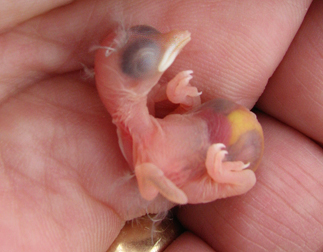
- The flanges reflect ultraviolet light, which is invisible to us but which most birds can see. This may help make a nestling’s open mouth more noticeable to adults.
- A nestling’s gaping mouth with its colorful flange acts as a beacon to attract its parents’ attention, and forms an effective target for food placement in the dimness of a typical Tree Swallow nest cavity.
You may find newly hatched nestlings whose down is damp and matted. Why is this?
- Damp, matted down feathers on the head and back indicates the nestling hatched very recently. Remember, the interior of the egg was mostly wet.
- Within a few hours, the down is dry and fluffy (see below).
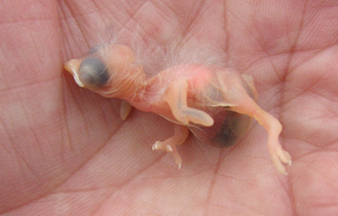
How are baby Tree Swallows different from baby chickens or ducks?
- Though they aren’t really independent, baby chickens and ducks leave their nests after hatching. They are mobile, able to see, and able to feed themselves almost immediately. We call these developmentally advanced young “Precocial.”
- By contrast, typical songbird hatchlings like the Tree Swallow in the photo above can’t do much more than beg, eat, digest, and defecate. They must undergo much more development before leaving their nest. Until then, they are totally dependent on adults. We call young of this type “Altricial.”
Why do eggs hatch after a particular number of days of incubation?
- Each species’ embryos hatch after they develop as much as they are genetically “programmed” to do within the egg.
- By this time, the growing embryo has nearly used up the original supply of fuel and raw materials in the egg. Anything required for further growth and development must come from outside. To obtain them, the embryo must hatch.
Where will new fuel and raw material come from?
- Hatching Tree Swallow nestlings are altricial, as we noted above. They depend entirely on adults for fuel and raw materials, in the form of invertebrate food items the adults catch and bring.
- Without sufficient food, a nestling’s development slows. Prolonged food deprivation can mean stunted growth or death by starvation and/or hypothermia.
How long does it take for all of a clutch of Tree Swallow eggs to hatch? Do they all hatch the same day or not?
- Hatch duration depends upon when females start incubating.
- If a female starts incubating after she finishes laying, her eggs normally all hatch on the same day.
- But, if a female begins incubation before she has finished laying, hatch will usually extend over more than one day.
- Some female Tree Swallows do finish laying before they begin to incubate.
- However, some other female Tree Swallows begin incubating on the day before they lay their last egg. In these nests, the last egg laid usually hatches one day after the others.
Won’t nestlings that hatch a day later be at a disadvantage?
- Yes, they often are. Upon hatching, these small Tree Swallow nestlings are smaller than their nestmates.
- Slightly older and larger young can beg for food more vigorously and reach out for it more strongly than the late-hatching, smaller nestling.
- If food is abundant, adults can usually supply enough so all young develop and fledge, despite sibling rivalry.
- However, when food is limited, bigger and stronger young will monopolize it and smaller, weaker ones may go without. If this situation continues, the smallest, often the last hatched, usually dies first.
- Notice how much smaller the nesting at right below is than its nestmates. It hatched from the last egg laid, a day later than the other five young. It will be at risk of starvation if food becomes scarce.
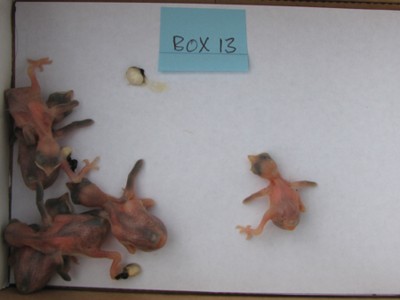
So why do some female Tree Swallows start incubating the day before they lay their last egg?
- This situation, where incubation begins before the last egg is laid, so that eggs don’t all hatch at once, is called “Brood Reduction.”
- Brood reduction is a genetically based tactic in Tree Swallows and many other birds that may increase the odds that at least some of a female’s remaining offspring survive if food is scarce.
- We see extreme brood reduction in birds like owls, where incubation begins with the first egg. This results in a very staggered hatch and nestlings of many sizes. When food supplies are poor, older owl nestlings may eat their younger, smaller siblings.
What should you do if you find dead nestlings in a box?
- Remove them and take them far enough from the nest box area so the odor of decay won’t attract predators to the nest.
Questions for the next Topic: Parental Care of Small Nestlings
- How do adult Tree Swallow lives change after their eggs hatch?
- What do nestlings need if they are to live to fledging?
————————————————————————————-
Home: Tree Swallow Nest Box Projects
Creating Tree Swallow Nest Box Projects
Spring Return
Nesting Season Behavior
Song and Calls
Nest Site Claiming
Pair Formation
Nest Building
Bird Flight
Mating and Paternity
Diary of One Season at Salmon Creek
Monitoring Nest Boxes and Keeping Records
Making Box Checks Keeping Box Records Control Sheets Season Summaries Print Sheets
Banding Your Tree Swallows Banding Adults Banding Nestlings
Tree Swallows in Research Research Bibliography Glossary of Terms